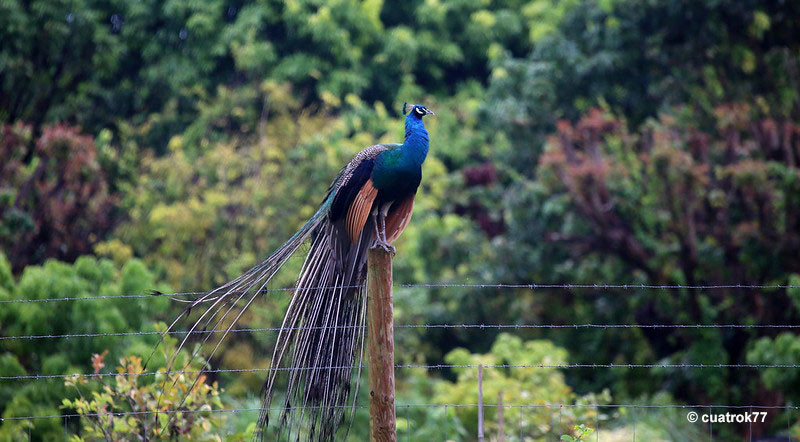 Peacock displaying
Peacock displaying
When we think of peacocks, or more accurately, Indian Peafowl, majestic images of vibrant plumage and ground displays often come to mind. These striking birds, members of the landfowl family, are frequently seen gracefully walking and running. This terrestrial preference leads many to wonder about their aerial capabilities: Can peacocks fly? And if so, How High Can Peacocks Fly?
The notion that peacocks are flightless is a common misconception, partly fueled by historical practices of wing clipping in domesticated birds and perhaps by their seemingly cumbersome size and elaborate tail feathers. However, the truth is, peacocks are indeed capable of flight. But to what extent do they utilize this ability, and what are the limits of their aerial prowess? Let’s delve into the fascinating flight dynamics of these magnificent birds.
Peacocks and Flight: More Than Meets the Eye
Yes, peacocks, or peafowl, are definitely able to take to the skies.
Despite their capacity for flight, it’s interesting to note that peacocks are not avid flyers. In fact, observations suggest they spend only a small fraction of their time airborne, around 2.6%.
This limited flight time is understandable when we consider that peacocks can weigh up to 13 pounds (6 kg), making them among the heavier flying birds. For these substantial birds, walking and running are clearly the preferred modes of transportation.
 Male and female peacock
Male and female peacock
Peafowl flight typically consists of powerful, short bursts. These bursts are crucial for navigating their environment, allowing them to overcome obstacles, reach food sources, seek refuge in trees for roosting, move between foraging areas, and, most importantly, escape from danger. Predators such as leopards, tigers, civets, feral dogs, and even startling encounters with humans can trigger a peacock’s flight response.
Related: What do peacocks symbolize?
Factors Affecting Peafowl Flight Ability
While adult peafowl are naturally equipped to fly when necessary, there are situations where you might observe a peacock struggling or failing to take flight. These instances can often be attributed to specific factors:
- Age: Peachicks, though precocial and relatively developed at hatching, require time to fully develop their flight skills. While they may start practicing wing movements shortly after birth, mastering true flight can take several months.
- Injury: Like any bird, peacocks can sustain wing injuries that impair or prevent flight. These injuries can occur at any age and significantly affect their ability to become airborne.
- Wing Clipping: Historically, and unfortunately sometimes still practiced, wing clipping involves cutting a significant portion of the flight feathers to prevent domesticated peacocks from flying over boundaries. This inhumane practice robs birds of natural behaviors and the ability to escape threats.
Flight Distance of Peacocks: Short and Sweet
Peacocks are not built for long-distance flights. They are considered short-distance flyers, ill-equipped for prolonged aerial journeys. While exact figures vary, the average flight distance for a peacock is up to 100 meters (approximately 320 feet). To cover greater distances, they often combine flight with strategic jumps from elevated positions, using gliding to conserve energy.
Unveiling the Vertical Limits: How High Can Peacocks Fly?
Peacocks are not particularly adept at quick vertical take-offs compared to many other bird species. However, they possess impressive jumping abilities, capable of leaping up to 6 feet from a standstill. This vertical jump acts as a crucial launchpad for their flight. By combining this jump with vigorous wing flapping, peacocks can reach heights of around 8 feet (2.4 meters) shortly after becoming airborne.
 Female peacock
Female peacock
This combination of jumping and short bursts of flight is perfectly suited for reaching their roosting spots at night. In their natural habitats, large trees can host hundreds of peacocks seeking safe overnight shelter in the canopy.
Interestingly, even when aiming for the heights of tree canopies, peacocks minimize actual flight. Their strategy involves reaching the lowest accessible branch using a combination of jumping and flapping, then hopping their way up through the branches to reach higher roosting spots.
This efficient climbing technique allows them to access roosting locations at impressive heights, ranging from 7 to 22 meters (approximately 23 to 72 feet), despite their limited flight capabilities. They prioritize vertical movement through climbing and hopping once they have gained initial height through a jump-assisted short flight.
Fun Facts About Peacock Flight and Behavior
 Peacock erching
Peacock erching
- Peahens are capable flyers too: Female peacocks (peahens), being lighter and lacking the elaborate train of the males, are arguably more agile in flight. However, scientific studies haven’t definitively proven superior flight performance in peahens, suggesting the train might not be as significant a flight hindrance as one might assume.
- The train is not the flight problem: Despite the visual spectacle of the peacock’s train, it’s not the primary reason for their limited flight. The bulk and overall mass of peacocks are the main factors contributing to their less efficient flying abilities.
- Running as a primary escape: Peafowl belong to the landfowl family (Phasianidae), which includes pheasants, grouse, and chickens. These birds share a common trait: stocky bodies adapted for ground movement. When faced with danger, peacocks instinctively prefer to run rather than fly, using flight as a last resort.
- Early flight attempts: Peachicks develop rapidly and are physically capable of flight as early as three days old. However, mastering flight is a learning process that takes time and practice, often requiring several weeks and up to six months for full proficiency.
- Modest flight speed: Peacocks can achieve a flying speed of around 10 miles per hour at their fastest, which is comparable to their running speed. It’s worth noting that extensive scientific measurements of peacock flight speeds are limited.
Frequently Asked Questions About Peacock Flight
Can female peacocks fly as well as males?
Yes, female peacocks, or peahens, are fully capable of flight. Being lighter and lacking the long train of feathers, they might even be slightly more agile flyers than males.
Is the peacock’s train a hindrance to flight?
While the train is substantial, it doesn’t appear to be the major impediment to peacock flight. The primary factors limiting their flight are their overall size and body mass, common characteristics of landfowl.
Can peacocks fly for extended periods?
No, peacocks are adapted for short bursts of flight. They are not endurance flyers and typically cover distances of only up to 100 meters in a single flight.
At what age do peacocks learn to fly?
Peachicks are physically capable of flight within days of hatching. However, they require practice and experience to become proficient flyers, a process that can take several weeks to months.
How fast can peacocks fly?
Peacocks can reach a flight speed of approximately 10 miles per hour, about the same as their running speed. However, detailed scientific data on peacock flight speed is limited.
